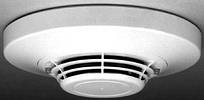
There are those who claim that aspiration systems are superior to spot detection, and have far greater sensitivity and a better speed of response.
There is some validity in this statement as aspiration systems have been successfully used in numerous installations around the world for over 20 years. The system has all but replaced spot detection systems in high-risk and special applications.
The latest aspiration systems generally use a laser based sensing chamber that can be adjusted to detect very small levels of smoke, typically with far greater sensitivities than that of spot detection systems. When demonstrated, aspiration systems [using a travelling suitcase demo system] do seem to provide very quick response to extremely small levels of smoke.

When they were first introduced some 20 years ago, aspiration systems met stiff resistance from the engineering community and end users alike due to the high cost of the equipment, and the fact that it was new technology. Now laser spot detection, while being considerably cheaper to install than aspirated systems, is also facing resistance, because it is ironically perceived as old technology.
However, it is important to remember that aspirated fire detection system technology is now at least 20 years old. Since the introduction of aspirated systems, there has been a paradigm leap in the technology of spot detection, which has allowed laser spot detection to become as good - if not better than, the best aspirated detection systems available today.
One of the main reasons aspiration detection is 'perceived' as having greater sensitivity than spot detection is due to the manner in which the system operates. An aspirated system works on the basis of detecting smoke through a network of 20 mm plastic conduit piping and a series of sensing points (holes drilled into the conduit). While it is true that an aspirated smoke sensing chamber typically has the ability of sensing smoke down to 0,0003%/m obscuration levels (far more sensitive than laser spot detection), it needs to be understood that the systems have to be sensitive due to the way aspiration detection systems sample smoke.

Smoke dilution
An example of this can be seen when a low energy fire occurs in an area protected by an aspirated system. In this scenario, smoke from the fire is drawn into the system through its sensing ports. While some of that smoke may be drawn into, say, one or two sensing ports, other ports will still be drawing in 'clean air'. By the time the clean air and smoke particulate reaches the aspiration sampling chamber, mixing of the air and particulate occurs in the pipe work. This produces a significant negative effect called smoke dilution.
Because of the dilution effect, inherently an aspirated system needs to be made more sensitive just to be able to detect smaller levels of smoke produced by this effect. On the other hand, laser based spot detection systems do not suffer from these dilution effects and therefore can be less sensitive whilst still providing the same level of protection. In fact, unlike aspiration systems, other spot laser devices can be configured through the control panel to actually aid the detection process and thus provide an even quicker response to small levels of detected smoke.
Some of the major factors that need to be borne in mind in the design and performance of a real-life aspirated system are as follows:
* The length of the pipe network - this can introduce significant 'transport' times into the system (ie the time taken for smoke to travel from a sensing port to the detection chamber - which could be up to 90 s).
* Whether the system is balanced or not - if the pipework is not balanced, there is a strong likelihood that smoke would take longer to reach the detection unit from certain pipe runs than that from other parts of the same network due to differing airflows.
* Negative pressure effects - caused by airconditioning plants or high external airflows in the protected area. This effect is a major problem as in certain cases smoke will never enter the pipe for sampling.
* Blocked sensing ports - sensing ports that are blocked by dirt and dust will alter the airflow and sensitivity per port in the rest of the pipe network.
* Installation practices - due to certain installation practices associated with the installation of aspirated systems, when the sensing ports are 'cut', variations can occur in the sensing port sizes which may differ from the original pipe work calculations. This could significantly affect the nominated sensitivity of each sampling port. A similar scenario will occur if de-burring of each port is not undertaken correctly.
Laser spot detection
Laser spot detection on the other hand, is unaffected by any of these abovementioned factors as each and every detector is an analog device with constant supervision for sensitivity by the control panel. The benefit to the end user is two-fold:
* The system is easier to install, less critical when designed, installed and commissioned.
* The system offers flexibility if and when modifications are required at a later date.
Therefore, the laser spot detection system can be used with a high degree of confidence as a cost-effective alternative to aspirated type systems, which can be installed in high sensitivity applications.
© Technews Publishing (Pty) Ltd. | All Rights Reserved.